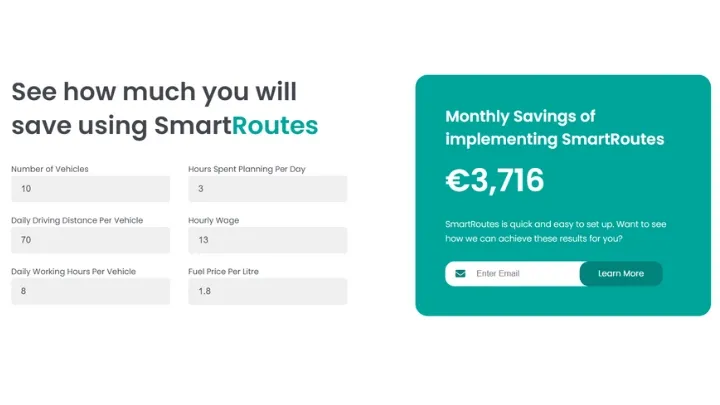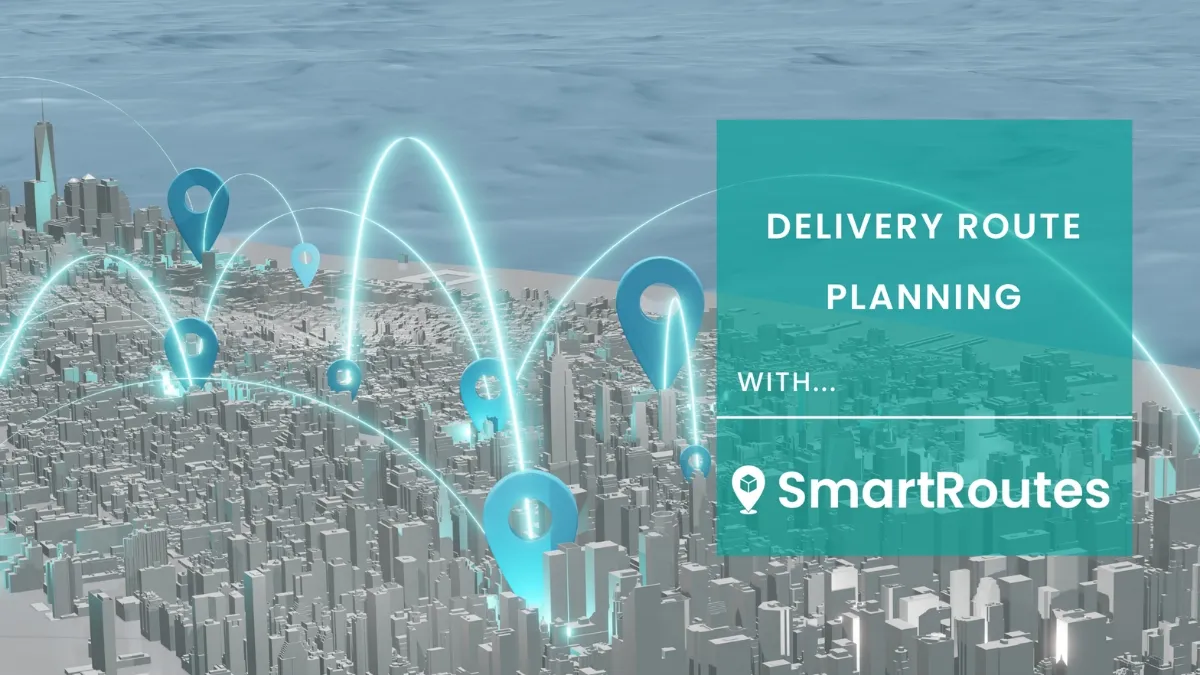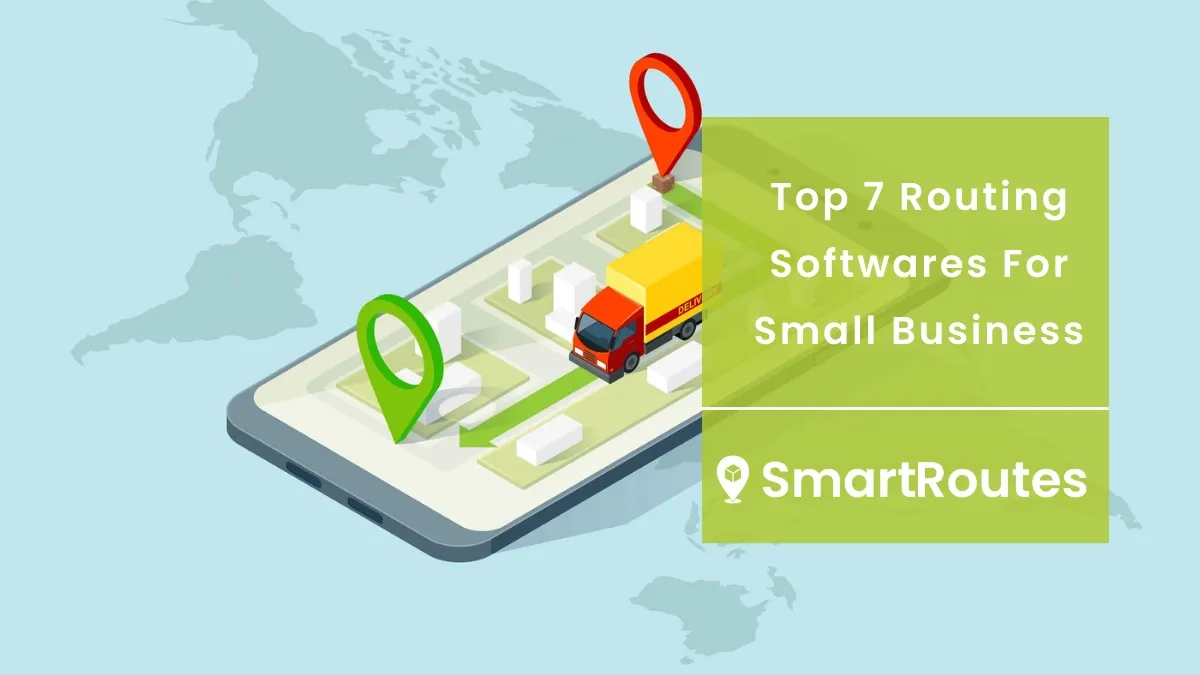What is ROI for route planning?
Route planning software comes at a cost. Whichever vendor you decide to use, you know it will have a monthly or yearly cost that you need to justify. The question is, how quickly will you see the outlay return to you? Or, what do you save for every dollar you invest in the product?
The good news is that we have built a simple ROI calculator for you to figure this out. The bad news is that return on investment is incredibly difficult to accurately measure or predict. In this article we will give you some idea of how to do it, see what other clients of ours have achieved, and tease out some of the secondary savings that accrue from implementing route planning and optimization software.

What you stand to gain from route planning software
Every company we (SmartRoutes) deal with comes from a different place in terms of operational efficiency. Some companies are still using pencil and paper and local area knowledge to map out delivery routes. Others already have route planning systems in place but are just missing something from what they have.
Obviously, if you have no system in place currently you stand to gain the most in terms of lower fuel costs, driver costs and administrative burden. For those who have systems in place currently it might come down to an individual feature like delivery notifications that are needed to improve successful delivery rates. This can have a huge impact on bottom line. The other factor to consider is the scale of your operation. If you have 100 vehicles then a 20% reduction in routes actually driven is going to have a much bigger impact than if you have 3 vehicles.
SmartRoutes Route Planning Software
Streamline your entire delivery process, all from one platform

Factors impacted by better route planning and optimization
Miles driven
Better routes mean shorter routes and the implications of driving fewer miles is that you have lower fuel costs or get more stops done in the same amount of time.
Driver salaries
Shorter routes mean drivers are on the road less and their shifts can be shorter with implications for salary costs. Many companies will even be able to deliver the same quantity of stops with fewer drivers.
Fleet requirements
Just like above fleets can often be cut because you can do the same work with 4 vehicles now instead of 5. This has implications for insurance costs, maintenance and even depot size. If you have a fleet of 50 vehicles and the route optimization improvements amount to a 10% reduction in miles driven then the choice for you becomes, do we retire 5 vehicles or do we increase our capacity for deliveries by 10%? It goes without saying, these are the conundrums you want to have. The other implication for fleets that are driving less is that there is less of a maintenance overhead because wear-and-tear is reduced.
Administrative planning improvements
Often overlooked in the return on investment conversation is the implication for administrative staff. Typically, we see transport managers, distribution managers, et al reducing time spent on planning and monitoring by 1 hour per day per vehicle. If the managers are being paid $20-30 hourly then this administrative salary saving alone is enough to justify the outlay.
Customer support savings
A route planning software comes with customer notifications and delivery live-tracking built in. This automation of the customer communication has huge benefits in reduction of customer support calls. We have seen companies being able to reassign customer support functions entirely as it is now handled automatically with a series of SMS, email and live-tracker communications.
Sustainability goals
Every company nowadays has sustainability goals built into their company objectives, particularly if they are operating fleets of vehicles. These sustainability goals can be expensive to achieve with carbon offsetting costs, operational initiatives and much more. Route optimization ‘delivers’ on sustainability goals as a by-product of the efficiency it creates. Calculating the monies saved by not having to reach sustainability targets with other means can be difficult but they are there.
NPS scores
Net promoter scores are an industry standard for understanding customer satisfaction. For clients of ours who measure NPS regularly we always see an upward trend in this figure upon implementing route planning because customers have a better experience overall with the delivery management system. This has huge implications for customer retention, repeat ordering and ultimately revenue. Again, this is hard to quantify in terms of a direct ROI but the potential upside is huge.
Operational efficiency
Finally, and perhaps most importantly is the overall operational efficiency of a company as a result of taking control of route planning. Companies can now see in real-time what parts of their routes are inefficient or not cost effective for the business. Companies can take orders from customers much closer to the delivery time because pickers get their orders automatically, as do drivers. Dispatch can set up highly efficient zones or territories that minimize driver’s commutes to and from depot locations. The implications are endless in terms of process improvements and all of them come with cost savings and a better customer experience.
Case Study: Grocery home delivery ROI
One of our customers, a grocery chain with a national home delivery fleet, is a good example of a broad array of positive returns from route optimization implementation.
They started using enterprise route planning software to replace a manual process managed at a local level by each store manager. Their return on investment was across a number of areas:
Less mileage
They saved 15% on routes driven in initial testing with further improvements expected.
Better territory management for deliveries
They implemented zones for deliveries cutting out overlap in delivery areas between adjacent stores. Essentially, stores in adjoining suburbs were delivering to the same street unnecessarily.
Improved and expanded ordering experience for online customers
They were able to take orders right up to midnight every day for delivery the following morning. This had not been possible previously with orders being fulfilled the 2 days after online purchase.
Scaled back fleet requirements for national home delivery project
They were able to reduce capital expenditure on vehicles by 5% and their fleet hire requirements by 8% subject to operational capacity testing. This resulted in significant improvements to balance sheet for the fiscal year offsetting software outlay in total.
Customer satisfaction increases and social media buzz
They saw a 10% increase in NPS scores overnight after implementing live tracking of grocery deliveries to customers. Customers were even sharing their live tracker map on social media as an example of great delivery service.
Admin time savings
They cut out 3 hours of administrative planning per store per day. Estimated to save 120 man hours per day.

Taken together the greater efficiencies and operational improvements were hard to quantify exactly but the management team projected conservatively a 900% return on investment from implementing route planning software compared to previous processes. It also allowed them to roll out home delivery to rural stores with confidence.
If you're ready to begin planning and optimizing routes for your business, you can avail of a 7-day free trial with SmartRoutes or get in touch today and a member of our team will be in touch.
FAQ
1. How can route planning software contribute to cost savings for businesses?
- Reducing Fuel Costs: By optimizing routes for the shortest distances and minimizing idle time, businesses can cut down on fuel expenses.
- Minimizing Vehicle Wear and Tear: More efficient driving routes help decrease wear and tear on vehicles, extending their lifespan and reducing maintenance costs.
- Improving Resource Utilization: Optimal schedules and routes reduce the need for additional vehicles, leading to better resource utilization and cost efficiency.
- Enhancing Overall Operational Efficiency: Improved routing leads to increased productivity and reduced labor costs, contributing to overall operational efficiency.
2. Is route planning software suitable for small businesses, or is it more beneficial for larger enterprises?
Route planning software is suitable for businesses of all sizes. While larger enterprises may benefit from its scalability and advanced features, small businesses can also leverage its capabilities to enhance efficiency. Many route planning solutions offer flexible options that cater to the specific needs and scale of both small and large businesses.
3. What measurable impact does route planning software have on operational efficiency?
- Reduced Delivery Times: Optimized routes ensure quicker deliveries, improving overall service efficiency.
- On-Time Performance: Businesses can track and enhance on-time performance for deliveries and field services.
- Increased Productivity: Efficient routing leads to more tasks or deliveries completed in a given time, boosting overall productivity.
- Data-Driven Decision Making: Analytics tools provide insights for continuous improvement and informed decision-making, positively impacting operational efficiency.
4. Can route planning software integrate with existing business systems and technologies?
Yes, route planning software often offers integration capabilities with various business systems and technologies. This may include Customer Relationship Management (CRM) software, Enterprise Resource Planning (ERP) systems, fleet management solutions, and other relevant platforms. Integration enhances overall business processes by providing a seamless flow of information and improving cross-platform functionality.
If you enjoyed this blog, you might also be interested in:




